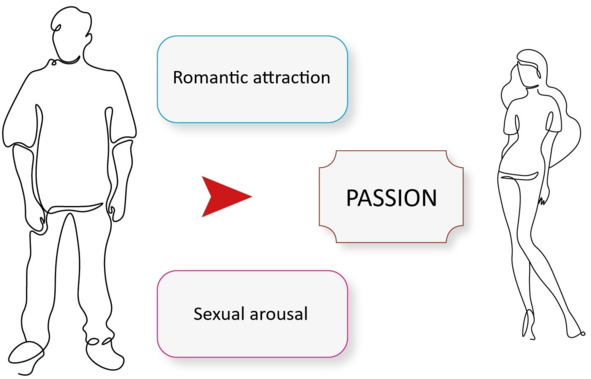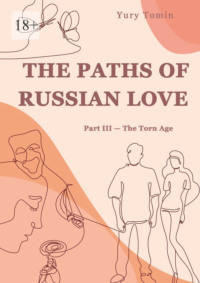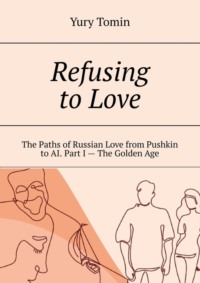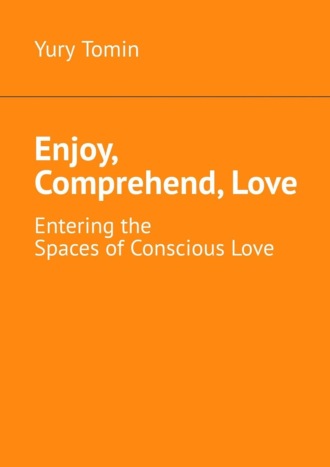
Полная версия
Enjoy, Comprehend, Love. Entering the Spaces of Conscious Love
As Professor Mitchell Greene of Edinburgh University puts it today, the lesson of Socrates is that without examining our own qualities, experiences, preferences and what really benefits us, we impoverish our own life, make it less meaningful, insufficiently virtuous and incompetent. Choosing the path of exploring our own existence, we insure ourselves against many unpleasant surprises that are possible in life. The main question related to the study of one’s own life, in a modern way, sounds like this:
Is this really what I truly want?
Let’s try in the same vein to ask questions inherent in conscious love. They might look like this:
To what extent have my expectations been met during the actual relationship?
Would I like to make our relationship lighter and brighter?
How conscious am I in my relationship with my partner?
Depending on the answers to these questions, you may appreciate the need for a deeper understanding of love and relationships with your chosen one.
With the book you will hopefully have an exciting journey through the spaces of conscious love. However, this is not an excursion for the sake of idle curiosity and not a mass tourist route. Developing the ability to love will require your active participation. It will be a joint exploratory trek through the little-explored, full of paradoxical phenomena, spaces of love relationships. Enjoy, Comprehend, Love
BEING IN LOVE AND LOVE
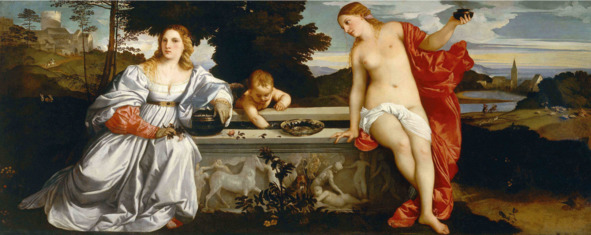
Sacred and Profane Love. Titian, 1514
Starting a dive to the origins of love, where things that await us are, according to Ortega y Gasset, “mechanical, formulaic and, in essence, spiritless quality,” it will not be superfluous to re-read the poem by Anna Akhmatova, replacing the word “poem” with “love.”
Now, having admired the work of the magic wand of “joy,” we can confess, together with Alexander Pushkin, that when we fall in love, we are glad to be deceived, despite the “sickness of love in my soul.” It has long been observed that in life, as in most literary works, the incomprehensible romantic epic of lovers unfolds in a bizarre combination of the euphoria of joy and the experience of love sickness.
If you do not rush headlong into one extreme or another and do not flounce between them, then you can go in two ways: try to find something special, really sprouting from these poles of the crystal sphere of love, or recognize all this as an illusion, deception, a game with a hidden purpose.
How, then, should one move towards the comprehension of love, which, undoubtedly, is a complex, multifaceted and at the same time an energetically intense and emotionally charged phenomenon?
We propose to start by listening sensitively to the very sensations and experiences of love, and in this we will rely on poets, and then we will try to carefully discern the core, which is a full-fledged single source of the entire diverse palette of feelings of love. And if we guess it, we can determine the assemblage point for filling the pyramid of knowledge about love.
There is a treasure in my soul
And the key is entrusted only to me!
Alexander Blok. The Stranger I wish you knew the kind of garbage heapWild verses grow on, paying shame no heed,Like dandelions yellowing a fence,Like burdock and bindweed.An angered yell, the bracing scent of tar,And walls with runic mildew like a sign…And soon a tender, testy poem answersTo your delight and mine.Metamorphosis of the Self
First of all, falling in love with another person means moving into a different state, which is revealed by a new quality of inner sensations and perception of the external world. This new state, a different reality of the Self, permeates and captivates the person in love. All our mental processes (sensations, perceptions, thoughts, decisions, behavior) are enlivened, filled with high energy, bursting beyond their usual boundaries, expanding their horizons, and entering new orbits.
In this state, we admire the object of love, look around differently and at the same time rediscover ourselves: we involuntarily feel a change in our inner tone, we are surprised to discover new traits in ourselves, carefully listen to the emergence of something unusual and at the same time joyful and with satisfaction we plunge into a previously unknown bliss.
A mosaic of new internal processes and previously unfamiliar qualities can fleetingly or for a longer time form into a single picture of some kind of internal harmony so that we kind of begin to see ourselves from the outside, benevolently contemplating our new incarnation, but at the same time not being completely sure that all this is happening to us. Such an unexpected gift of falling in love – a breakthrough into a parallel contemplative state, seeing yourself from a different assemblage point – is similar to the state achieved in the process of meditation, but you experience it not in solitary silence, but in a seething accelerated life stream.
This new self-image, born of falling in love, ghostly and fleeting, and at the same time beautiful and alluring, becomes our new inner reality. It begins to influence all our mental processes. We can no longer evaluate, decide and do something the old way – a more significant, more understanding and more confident inner voice begins to interfere in everything. Our Self begins to transform in the direction of this new image.
In those moments of falling in love, when our consciousness becomes light and airy, we can also feel the fantastic plasticity of the outside world, because under the influence of our thought and will it transforms as we wish. Unfortunately, we cannot stop these moments, they only open the veil of possibility to the innermost desires of our soul.
The following quote is not lines from a fiction book: “he felt completely independent of the body: he moved without muscle effort and felt that he could do anything. He was sure that he would fly up or move the corner of the house, if necessary,” this is the state of love of Konstantin Levin (a rather mature thirty-two-year-old man, the hero of Leo Tolstoy’s novel Anna Karenina).
The phenomenon of going beyond the boundaries of one’s own Self is a surprise not only to the man in love, but also to those around him – his behavior is so unusual, mysterious and inexplicable. Only a few from the inner circle and sages can take to heart and share what happens to a person in love. It is even more difficult to describe it in words or convey it in clear images.
Let’s try to take a closer look at Vladimir Nabokov’s description of in the poem of the same name. This poem is remarkable in that the author, having composed it in Russian and passed it on to his beloved in English translation, comments on what he wanted to express in “philosophical love verses.” Being in Love
The poems I started composing after I met Iris were meant to deal with her actual, unique traits <…> My instrument, however, was still too blunt and immature; it could not express the divine detail, and her eyes, her hair became hopelessly generalized in my otherwise well-shaped strophes <…> On the night of July 20, however, I composed a more oblique, more metaphysical little poem <…> The title of the poem <…> – Vljublennost’, which puts in a golden nutshell what English needs three words to express.
Looking into himself, the young poet discovers that being in love is not only our fantasies about the charms of the beloved, but first of all it is a special state of our Self and, moreover, “a reality of a different kind,” which is terribly unreliable, but attractive in its boundlessness and mystery.
It is quite shared, but not obvious, the young poet’s fear and his unwillingness to look into the half-opened slit of the future. What is there really to be afraid of the lover? Not at all infernal darkness, as one might think, but the return of the Self transformed by love into ordinary reality, the foretaste of which brings gloomy tones to the vivid picture of being in love.
(Those who are interested in the girl’s reaction to these verses, her questions and the poet’s explanations, I refer to Vladimir Nabokov’s novel ). Look at the Harlequins!
The poetic metaphors of Vladimir Nabokov’s quite accurately expressed the main directions of the profound comprehension of love. Vljublennost’
At almost the same time, Ortega y Gasset published his , in which the philosopher presented, based on keen reflections on the nature of love, his understanding of the core content of love as going beyond one’s own Self. Etudes on Love
In , he sets out to define and understand what is love between a man and a woman “in itself as such.” What filled the theme of love at the beginning of the 20th century, he considered unsatisfactory. On the one hand, these were numerous “love stories” where the essence of love was blurred by various circumstances. On the other hand, there were obvious mistakes in the “theories of heart feelings” created by the great philosophers. The settled reduction of love to “desire, attraction, striving for something” (Thomas Aquinas) cannot act as the main content of love, since desire dies, and “love is eternal dissatisfaction.” Also, for love itself, one cannot take its positive emotional manifestations, such as “the joy of knowing the object of love” (Benedict Spinoza), since love happens to be sad, hopeless, causing torment and suffering. Etudes
Ortega y Gasset sees a completely different core in love and concludes: “In an outburst of love, a person breaks out of one’s Self; maybe this is the best thing that Nature has come up with so that we all have the opportunity to move toward something else in overcoming ourselves.”
Having defined the primary content of love, he emphasizes its essential qualities. The feeling of love “in its innermost intimacy as a manifestation of inner life” is:
– active emotional practice, caring;
– continuous spiritual radiation emanating from the lover and directed to the beloved, enveloping him with warmth, tenderness, and contentment;
– invisible connection, where hearts beat nearby at any distance;
– life-affirmation, creation and nurturing the object of love in the soul.
Ortega y Gasset insists that by following this theory of love, one can separate true love from pseudo-love. At the same time, the emotional composition of true love does not change, despite a long separation and a change in the physical condition or social status of the object of love, since it comes from a new person transformed by this love.
Let’s try to summarize our reasoning about the “frenetic stage” of love. In the state of falling in love our Self discovers and penetrates into another (internal and external) reality, acquires tremendous mental strength, overcoming any burdens, feels the possibility to get closer, and in some ways even gets closer to the Self-ideal and in this new quality enjoys the meeting with the equally ephemeral ideal image of the partner.
Spaces of desire are materialized by the field of action. It is difficult to predict what the result of the process of our inner transformation and change of our position in the world around us launched by falling in love will be, but we can assume that success will depend not so much on our initial abilities to live and love, as on commitment to the image of our boundless Self that has so wonderfully opened up.
There is a rather long period of time before the main test of the Self transformed by falling in love – the collision with reality – which is estimated by psychologists to be from six months to a year. In the meantime, under the influence of these unusual mental transformations, such facets of love as passion and intimacy are surprisingly revealed and filled.
We will now move on to consider these major energies of love, but we will conclude this topic with three additions.
First, let's decorate our reflections with the following quote:
– asked the English philosopher Francis Bacon 400 years ago and answered with conviction: Don’t you see that everyone is looking for himself? – And only the one who loves finds.
Second, let’s explain another participatory thinking technique used in this book. We will periodically return to the main provisions of the theory of conscious love in order to see them from a different angle based on new considerations, to connect them with other levels of their manifestation and to consider the clarifying questions that have arisen. So we will continue to wash the bones, or, more precisely, the gears, of the transformation processes of the Self
Third, I suggest that you independently reflect on the proposed schematic illustration of the transformation of the Self in love.
Now we have to mentally master such a willful part of the psyche as passion.
Transformation of the Self in love: intense internal processes, a new perception of the world, going beyond the limits of the Self, staying in the image of the Self-ideal, interaction with the ideal image of a partner.
We forget that being in loveis not just the facial angle of the loved one,but is a bottomless spot under the nenuphars,a swimmer panic in the night.While dreaming, dream of being in love,but do not torment us with awakening,and reticence is better,than that chink and that moonbeam.I remind you that being in loveis not sheer reality, that the markings are not the samethat, may be, the hereafterstands slightly ajar in the dark.
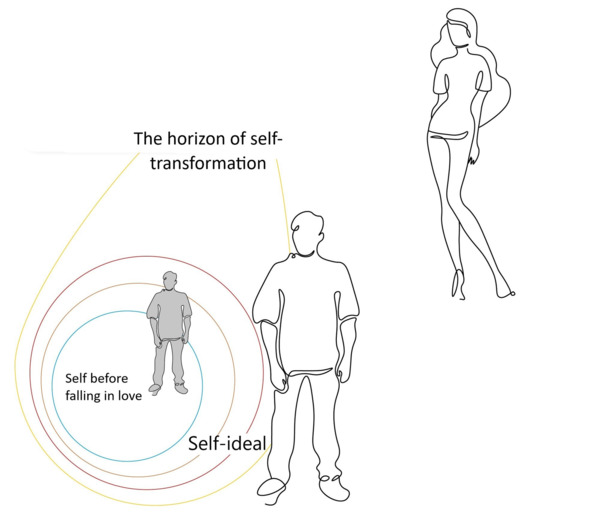
Passion
Passion, or the irresistible desire to get close to the object of love, has two components: sexual and romantic.
In psychology, sexuality is associated with erotic arousal, involuntary attraction and instinctive behavior towards people of the opposite sex. These physiological and behavioral responses are well studied, and the so-called human sexual response cycle acts as the center of attraction for them.
The characteristic stages of the cycle of sexual pleasure are the arousal phase for certain erotic stimuli, the plateau phase, orgasm, and relief. The average length of the cycle ranges from 3 to 7 minutes. After reading these medical details of sexual intercourse, anyone who has experienced love will feel that something most important has been missed, perhaps because it is difficult to express in words, much less to measure. But what certainly raises suspicion is the adequacy of the scale of psychological stopwatches. The fact is that erotic caresses and the plateau phase in sexual intercourse can be felt as endless pleasure, and physiological cycles can stretch immensely in time or immediately resume. Lovers may involuntarily plunge into a state of subtle vibrations, an analog of which is purposefully achieved in tantric practices.
We will return to the discussion of these and other features of the sexual element of passion in the section , but now let us turn our attention to the much more interesting, but overshadowed by its erotic counterpart, the romantic component of passion. Sexual Activity
The romantic ingredient in passionate attraction is associated with an increased intensity of emotional reactions and a stormy activation of the imagination of partners, inspired by love.
The content of fantasies embracing lovers is filled with the idealization of everything that surrounds them, as well as with heroic images, adventure plots, and sometimes mystical insights. It is no coincidence that lovers are so susceptible to fortune-telling, omens, and other mysterious rituals. The underlying basis of these processes can be described in terms of the concept of archetypes proposed by the founder of analytical psychology, Carl Gustav Jung.
The hidden layers of our psyche, formed by the collective unconscious, open before the inspired Self of the lover. These experiences are reflected in the mind by certain archetypal images and symbols (seeker, warrior, magician, sage, jester, creator, ruler, Don Juan, etc.), which push its usual boundaries and stimulate the expansion of the lover’s personality. Hence follows the various romantic obsessions of lovers: creative inspiration, ardent affection, willingness to eliminate any rival or offender, actions involving unjustified risks, wanderings, and other unusual states and deeds.
Stormy mental processes in a state of romantic attraction in the recent past were mistaken for mania, insanity, mental disorder. This terminology, albeit in a somewhat simplified sense, is still used today to describe falling in love in both fiction and scientific literature.
Let’s take a small digression to look at the approaches proposed by science to the description of the passionate attraction that interests us.
In psychology, the romance of being in love, scientifically speaking, “the tendency of people to establish strong tender attachments with singled out people”, is addressed in attachment theory, which draws on patterns of mother-child relationships, along the lines of obtaining security, support, reassurance and encouragement.
In 1979, American psychologist Dorothy Tennow expanded attachment theory with the concept of limerence to characterize the special romantic state that suddenly fills the minds of lovers. She identified the typical signs of such a state, but she was unable to identify a single pattern (cause-effect relationship) of the emergence of romantic feelings.
In the process of attachment formation, Tennov noted, “emotions of affection and admiration involuntarily arise, accompanied by uninvited obsessive thoughts, feelings, actions ranging from euphoria to despair, depending on the perception of feelings of reciprocity.” The state of limerence pulsates on a balance of uncertainty and hope, and then fades away after the moment of sexual intimacy or engagement. Such a state can be quite long (from 18 to 36 months), but it is unstable and turns into a caringly tender relationship or fades away irrevocably and sadly.
Falling in love continues to be a difficult problem in science, just like the problem of consciousness. In order to be convinced of this and yet discover some of the habits of this willful energy of love, let us follow in the footsteps of its literary images.
The case of the rise and fall of tender affection about two centuries ago was vividly described by Nikolai Karamzin in “Their dates continued; but how everything has changed! Erast could no longer be content with only the innocent caresses of his Lisa – her glances filled with love – one touch of the hand, one kiss, one pure embrace. He wished for more, more, and, finally, could not desire anything – and whoever knows his heart, who has contemplated the nature of his most tender pleasures, will certainly agree with me that the fulfillment of all desires is the most dangerous temptation of love. Liza was no longer for Erast this angel of purity, which had previously inflamed his imagination and delighted his soul.” Poor Liza:
This love story is also significant in that other horizons were opening up for Erast, and he conceived a noble transformation of his Self:
All the brilliant amusements of the great world seemed to him insignificant in comparison with the pleasures that this passionate friendship of an innocent soul nourished his heart. With disgust, he thought of contemptuous voluptuousness with which his senses had formerly reveled. ‘I will live with Liza, like brother and sister,’ he thought, ‘I will not use her love for evil, and I will always be happy!’
Perhaps the case of Erast can be declared a common noun for all those cases when the impulses of the soul in love are noble, but the mind and will of love for the transformation of the personality are too weak. Observing Erast’s case, one can only lament after Nikolai Karamzin: “Reckless young man! Do you know your heart? Can you always be responsible for your movements? Is reason always the king of your feelings?”
In a state of love, questions about understanding oneself, about the ability to curb impulses of passion are more acute than ever, and here either a decisive step is taken towards the ancient calls “Know thyself” and “Nothing beyond measure”, or our Self becomes even more fragmented and settles in the dark corners of consciousness.
Not long before Karamzin, Johann Wolfgang von Goethe asked the question of “what is the human heart” in his famous novel . The Sorrows of Young Werther
Goethe paints a heartfelt picture of pure, as Napoleon put it, “great passion”, which grows almost entirely out of the hero’s romantic fantasies, but this does not make it any less suicidal. It is no coincidence that Werther feels a kindred spirit in children and is moved by their “naive persistence of desires.” Perfectly aware of the diabolical power of fantasies, that “people would suffer much less if they did not develop the power of imagination so assiduously”, he nevertheless becomes a victim of his own irresistible passion. Werther is forced to admit: “that grain of reason, which he (man), perhaps, owns, almost or does not matter at all when passion rages and he becomes cramped within the framework of human nature.”
What, then, could be the cause of such exceptional pernicious passion? If one assumes, as Werther’s beloved does, that the very fact of her inaccessibility is the reason for this, then the whole point is in the manic obsession of desire. However, Werther’s incurable suffering lies elsewhere. He finds himself in a double trap: passion strips him of his reason and thus his humanity, but also the diminution of passion would mean the loss of his own unique humanity. For him, it is obvious that the heart is higher than the mind: it is “my only pride, it is the only source of everything, all strength, all joys and sufferings.” At the same time, Werther’s sensitive heart knows that high passion completely subjugates the soul, since “wandering in blissful dreams bestows the highest happiness.” But when “nature cannot find a way out of the intricate labyrinth of conflicting forces”, – “man dies.” In other words, in love the soul acquires the highest happiness, but reason, rules, circumstances force the soul to abandon it, find a substitute and be comforted, and this is tantamount to the death of the soul.
Another extreme manifestation of passion is its overwhelming preoccupation with sexual arousal. However, no matter how exciting the sexual experience, something tells lovers that the sexual component of passion is less connected with the only object of love than the romantic one. Perhaps Konstantin Balmont and Alexander Blok guessed this in their poems:
***
Summarizing our reasoning about passion as the motivational energy of falling in love, we note the mutual influence of its two components – sexual desire and romantic attraction. Moreover, the sexual drive is largely determined and transformed by our imagination, which, in turn, is abundantly nourished by romantic fantasies. But this transformation of sexual passion is only a possibility, the realization of which depends on individual dramatic improvisations. In everyday life, everything is much more prosaic. And as if David Samoilov in his verses tries to warn people against the flat, ordinary intoxication with passion:
Passion ingredients: 1) erotic arousal, irresistible desire, sexual response cycle; 2) imagination, fantasies, archetypal images.
The one who heard the song of the primordial wave,Always full of boundless dreams.We are from the deep bottom, and at that depthMany virgins, many tender shells.I do not like slavery. With free gazeI look into the eyes of a beautiful womanAnd I say: “Today is the night. But tomorrow —A shining and new day. Come.Take me, solemn passion.But tomorrow I’ll leave and start singing.” My soul is simple…Passion is not at all a prototype of adultery.It neighbors blindness with epiphany,With immensity – an exquisite measure:The fusion of God and his creation.There is no lust in it. It smells no flesh.There is a spiritual passion. Everything else is a lie.